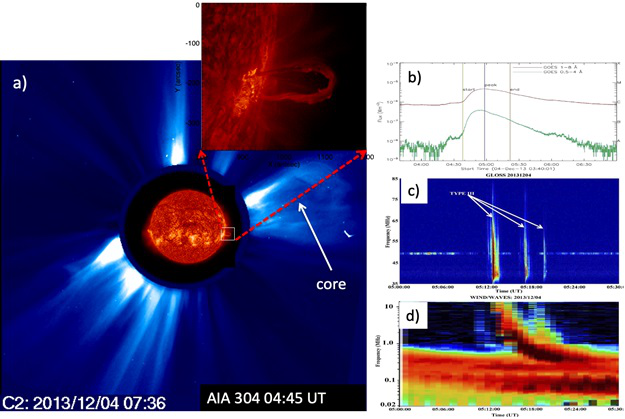Scientists probing the evolution of an eruption (PE) that occurred from the west-limb of the Sun in 2013 using several different ground and space-based telescopes have traced the source of the solar burst. This could help in better understanding of what makes space weather tick.
The sun often ejects plasma and magnetic fields in the form of coronal mass ejections. These CMEs are typically associated with features on the solar disk known as filaments or prominences. The triggering mechanisms of these erupting features are of great scientific interest in determining the speed of the CME and its impact on space weather, and hence the potential harm they can cause to our satellites and communication networks when they hit the Earth. Prediction of the exact path of the CME through interplanetary space, and hence its effect on Earth (or geoeffectiveness), is not easy, and is a subject of intense research. Therefore, studying CMEs that were geoeffective as well as those that did not make it, are both essential to make progress.
Using ground-based optical and radio telescope data, as well as data from space-based satellites of NASA, scientists from the Indian Institute of Astrophysics (IIA), an autonomous institute under the Department of Science and Technology (DST), Govt. of India, studied a unique prominence eruption (PE) that occurred from the west-limb of the Sun on 2013 December 4.
This PE was associated with a slow CME that propagated a distance of only 40 times the radius of the Sun in the Suns atmosphere, as well as a weak solar flare. It was found that the average acceleration of the prominence is quite small compared to strong flarse, which is why the associated CME was slower.
Unlike the other cases of strong CMEs, an imbalance of the magnetic forces triggered this prominence eruption said P. Vemareddy, the first author of the paper and a faculty member at the institute.
In addition, this flare was also accompanied by a type radio bursts called type III, which were recorded by the ground-based radio spectrograph from the Gauribidanur Low frequency Solar Spectrograph (GLOSS). GLOSS is operated by the Indian Institute of Astrophysics (IIA) at the Gauribidanur Radio Observatory. Generally, CMEs are accompanied by type II radio bursts due to shock-accelerated electrons, which are surprisingly not detected in this case., said Syed Ibrahim, a co-author and a post-doctoral fellow at IIA.
The scientists found that this prominence was located in a region with weak magnetic polarities. They explained that it is possible that a small quantity of magnetic field contributed to the magnetic reconnection, which led to the observation of only a weak flare. Magnetic reconnection is crucial for an eruption of a fast CME and happens when the geometry of the complex magnetic field lines rearranges itself and releases a vast amount of energy. Hence, flare magnetic reconnection plays a role as a feedback mechanism for the fast acceleration of the erupting feature, leading to a fast CME receding from the Sun. This study highlights the impact of magnetic reconnection on the speed of CMEs, launch of radio bursts, and the CME propagation distance from the Sun said P. Vemareddy.
The study published in MNRAS asserts that simultaneous multiwavelength observations from different vantage points are very important to reveal the origin of CMEs from the sun. In particular, imaging observations close to the Sun are the key to determine the speed of the CME which the space payload Visible Emission Line Coronagraph (VELC) onboard the solar space observatory Aditya-L1 is going to provide soon, P. Vemareddy pointed out.
Publication Link: doi: https://doi.org/10.1093/mnras/stad3323

Figure 1 Prominence eruption on 2013 December 4. (a) Combined images of LASCO/C2 and AIA 304Å showing the prominence eruption on the west limb has evolved to a white light CME. Inset is a magnified image of AIA 304 Å displaying the erupting prominence at 04:45 UT. (b) GOES X-ray flux profile showing the associated C4.7 class flare. Flare start, peak, and end times are denoted by green, blue, and red vertical lines; (c) the GLOSS dynamic spectrum shows the recurrent radio type III bursts during the flare peak time; and (d) the dynamic spectrum obtained by wind/WAVEs delineates the low-frequency type III burst.


























